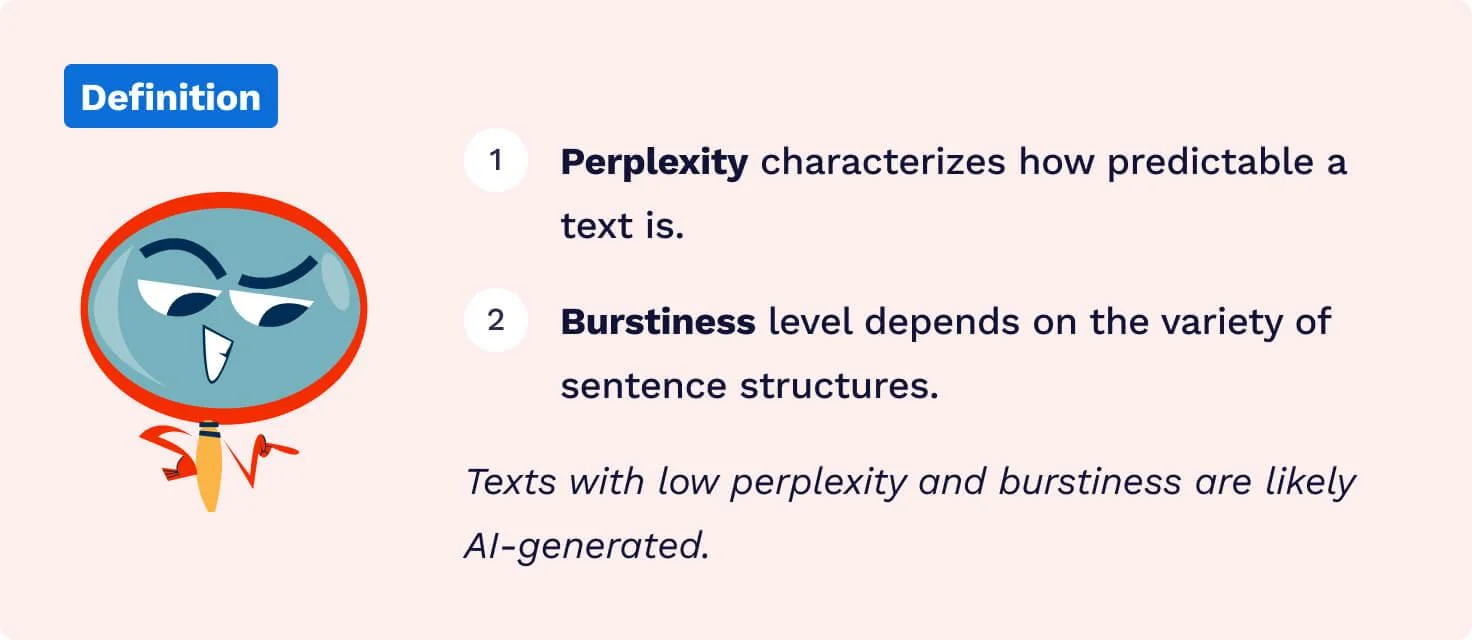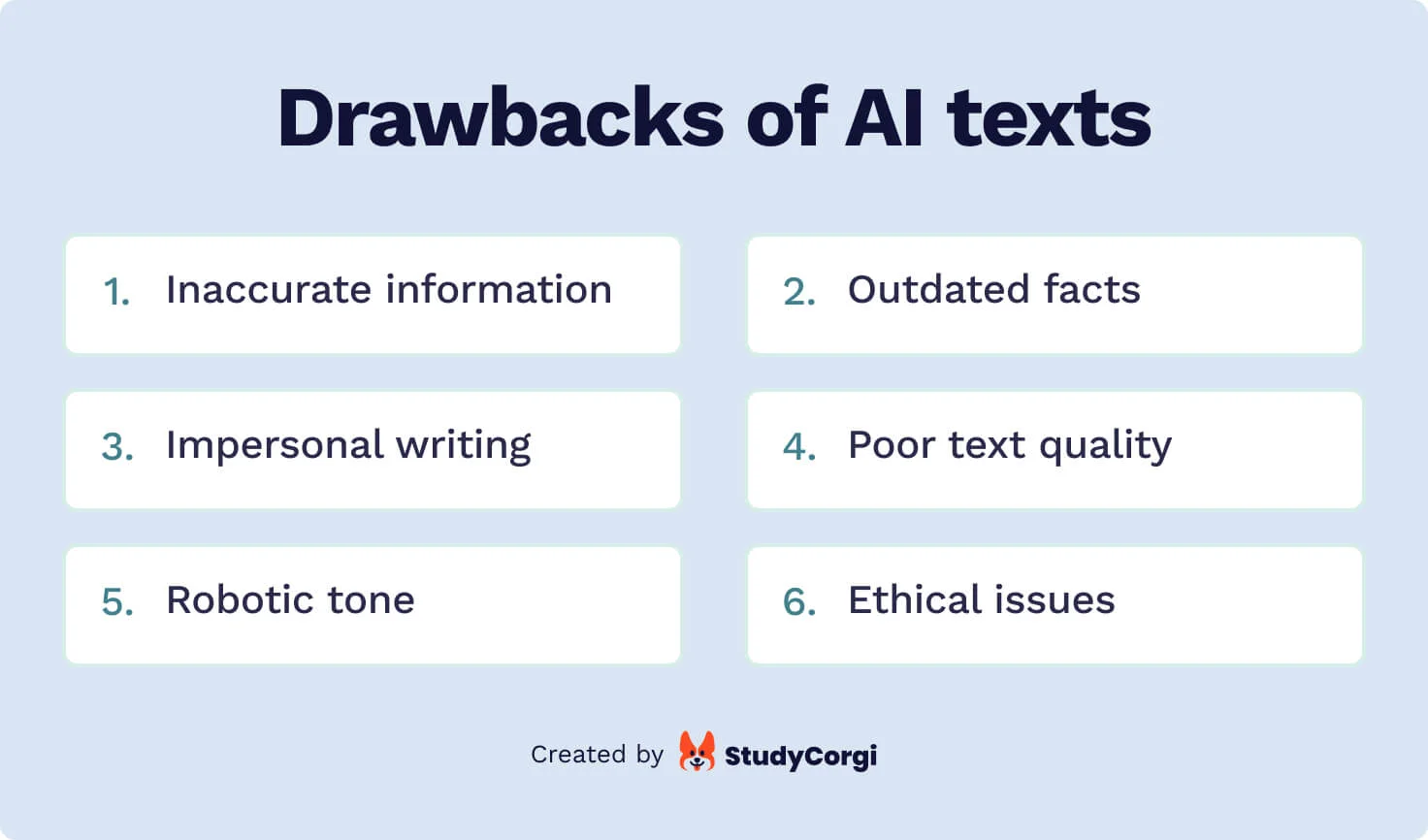🚀 How to Use Our Tool
One of the best things about our AI detector bypass is that it’s super easy to use:
- Paste the text you want to make more human-like into the converter.
- Wait a little while our tool adjusts your content.
- Get the improved version of the text along with the original. See the difference for yourself!
The resulting text will have a medium to low risk of being AI-generated. However, if your passage is too robotic, our tool will be unable to humanize it effectively.
Remember that the best way to get a fully AI-free content is to rewrite it from scratch.
✨ Why Choose Our AI Bypass Tool?
Here’s what makes this humanizer app so outstanding:
🤖 Who May Need to Humanize Texts?
Our AI bypass will be useful for diverse users. Yes, you’ve heard it right! This app is designed for a wide range of people, including:
- Students. Our tool will humanize complex scholarly articles, make generated essay samples more engaging, and help you avoid false cheating accusations.
- Teachers. Educators can apply our AI bypass to make learning materials more student-friendly.
- Researchers. This humanizer works like a charm for people who work on their research. It will improve the paper’s clarity and make it more comprehensible for an average reader.
- Marketers. If a marketer sounds approachable and human, it helps them sell their products. Our tool can help write messages that speak to people and pique their interest.
- Business professionals. Those who work in corporations can use our AI content humanizer for their e-mails, presentations, or reports to make them sound less robotic.
🔍 AI Detection 101
So, how do you recognize a generated text? Well, checking a passage for traces of AI involves analyzing two characteristics: perplexity and burstiness.
- Perplexity refers to the unpredictability of content. Tools like ChatGPT create texts that have low perplexity. What makes them predictable is that generative AI puts together words that are likely to follow each other. Humans, in contrast, tend to convey their ideas in a more varied and complex manner.
- Burstiness determines how length and sentence structure vary throughout a piece of writing. Language models usually produce sentences of similar length and use the most common structures. Low levels of burstiness indicate the text was most probably generated.
AI detectors help to determine the levels of perplexity and burstiness. Very predictable texts are flagged as generated.

In case you want to run a text through an AI detector, try our free ChatGPT essay checker.
📌 What’s Wrong with AI-Generated Content?
Many serious concerns arise with AI’s growing popularity and widespread use, especially among students. Even though generating content instead of writing it may sound like an excellent idea, it’s still much better to rely on yourself.
Why? Well, AI texts have plenty of drawbacks – keep reading to learn about them.
Outdated or Inaccurate Information
The primary reason why relying on AI tools might not be the best idea is that they often use outdated or inaccurate information. Sometimes, generative AI can conjure up stories and statistics that fit the text but are entirely fabricated.
The thing is that algorithms don’t understand the meaning behind the text. They simply string together words contained in their databases.
As a student, you want to do your best with your writing assignment and provide accurate information. That’s why, instead of having AI do all the heavy lifting, it’s better to take your time to research and verify everything with the help of credible sources.
No Personal Opinion
When professors assign students to write a paper, they want to see a combination of factual information and students’ perspectives on the matter. Since AI creates texts without understanding them, the content doesn’t express any opinion and sounds neutral.
In contrast, when an actual human writes an essay, it has a personal touch that might resonate with the reader. This helps establish a real connection in a way AI can’t replicate.
Poor Text Quality
Generated writings tend to overuse the same phrases and words. Since AI models cannot recognize and avoid redundancy, the produced content often sounds repetitive.
The fact that most artificial intelligence algorithms don’t consider context also makes generated texts vague. Human writers often add relevant details to their writing, especially when they have first-hand experience with the topic. Adding such specifics turns papers into more engaging and informative pieces.

In the case of AI, the text may look good, but if you examine it closer, all you’ll see is a collection of words that hold no meaning.
Robotic Tone
If you’ve worked with ChatGPT before, you’ll probably be able to recognize a generated text if you see one. That’s because machine-generated content has something “off” about it. Algorithms overuse certain patterns, and the resulting texts sound unnatural.
Most generators heavily rely on cumbersome sentence structures and add lots of unnecessary linking words to glue phrases together. This creates overly long sentences that sound robotic and are hard to digest. It also makes AI texts sound dry and ungenuine.
As a student, you want your paper to communicate your ideas clearly and concisely. Generated texts with long sentences, excess transition words, and repetitiveness are the antipode of that. So, are they really worth it?
Ethical Issues
The sudden rise in popularity of programs like ChatGPT has led to numerous instances of plagiarism. When students use tools to do their homework or write papers for them, it goes against the principles of academic integrity.
AI tools don’t come up with their own ideas but utilize already existing works to create new content. This means those who submit ChatGPT’s texts steal other people’s ideas and can be accused of cheating.
Still, there are ways to use AI ethically – for example, to generate essay examples for inspiration. Our humanizer tool will help you improve the readability of such texts.
And that’s it! We hope you’ve found our humanizer tool helpful and learned something new. Feel free to use other tools for students, such as our hook generator.
Updated: